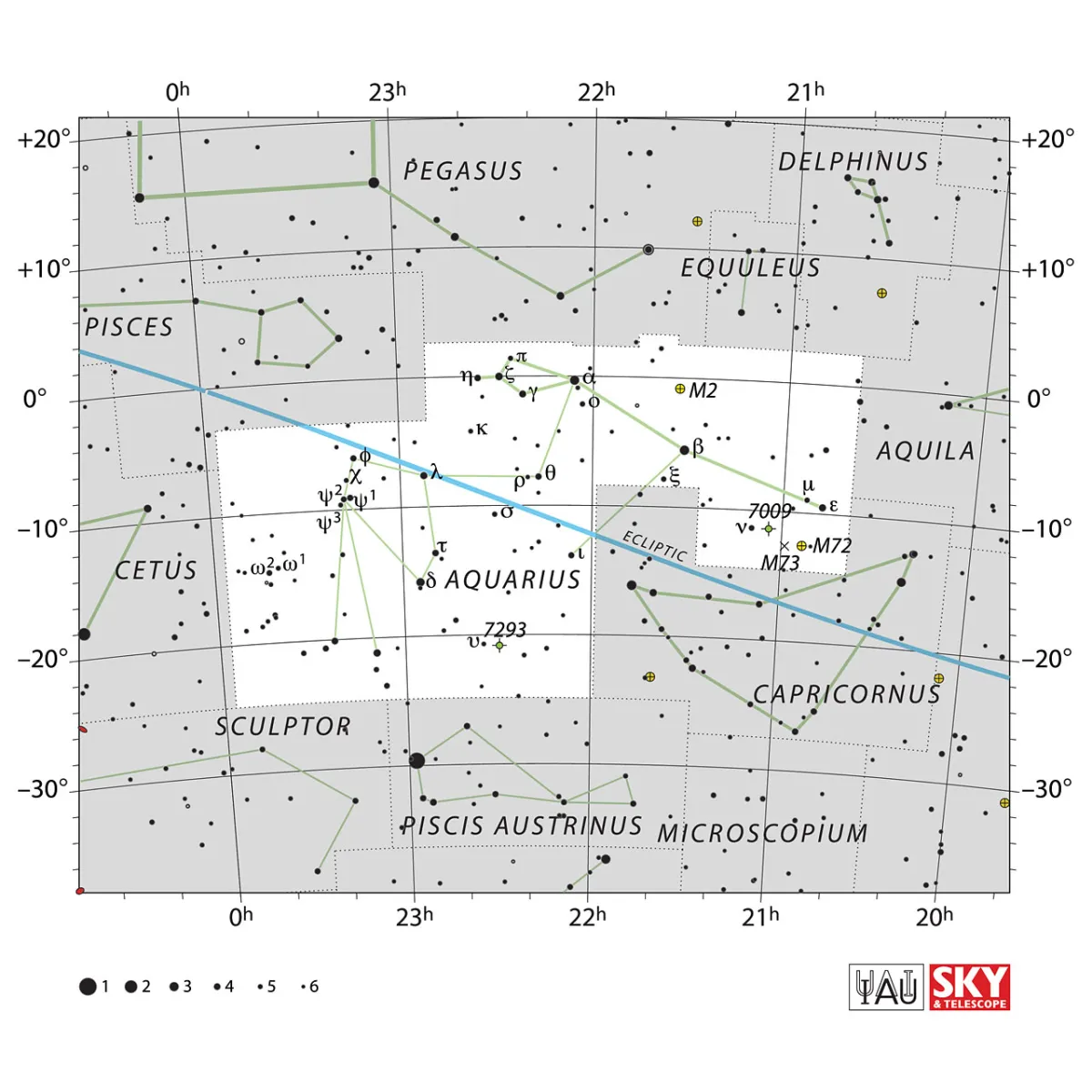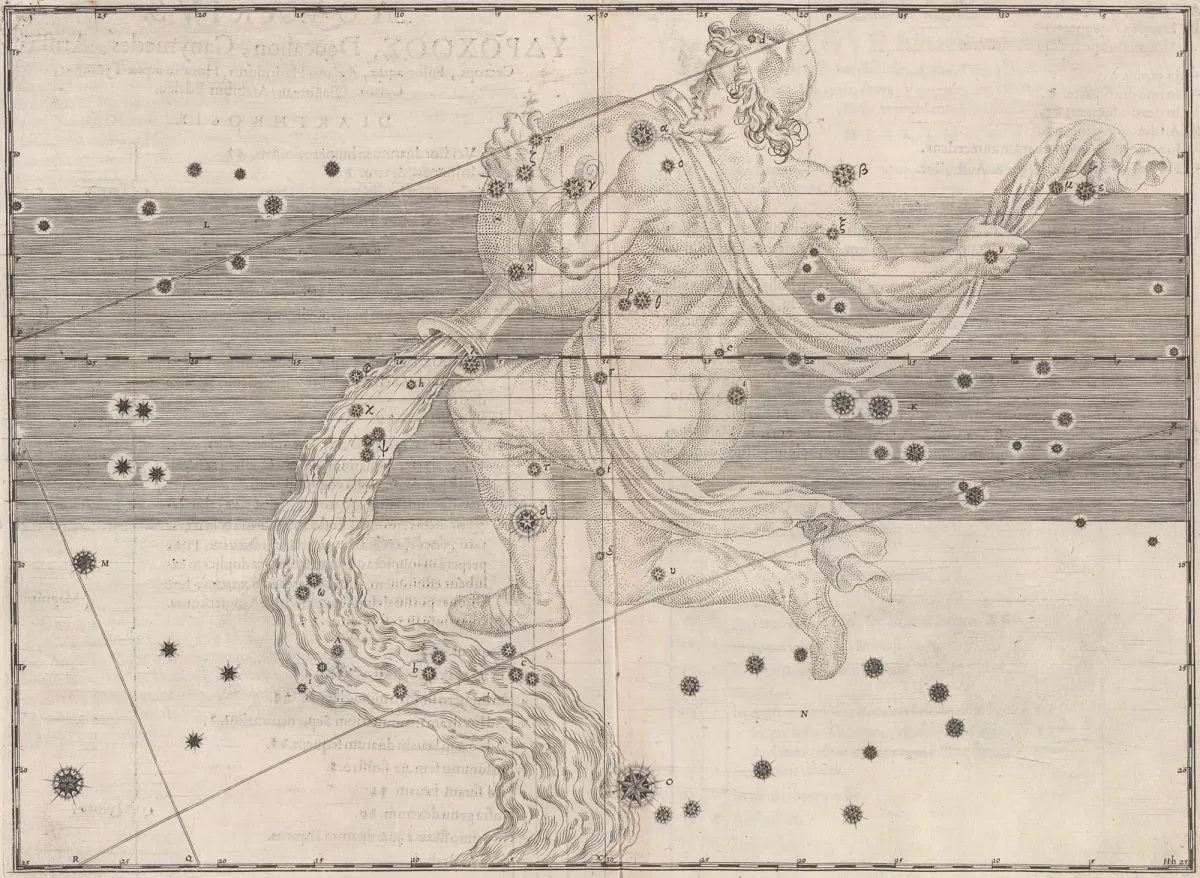Constellation Aquarius (Water Bearer)

Properties
The constellation Aquarius is in the ecliptic, southwest of the large Pegasus rectangle. The stars in Aquarius are not particularly bright and form a form that is difficult to understand figuratively. The most striking part is probably the y-shaped group of stars with zeta Aquarii in the centre, which marks the jug itself. [7] In the southeast corner of the constellation area there are three distinctive star groups, each consisting of 3 to 4 stars, which symbolize flowing water that is snapped up by Piscis Austrinus. The constellation is very large with an area of 980 square degrees and extends over three hours in right ascension. The centre culminates at midnight on around August 26th. [9, 15]
| α Aqr | Sadalmelik, Sadalmelek, Sadlamulk, El Melik, Saad El Melik |
| β Aqr | Sadalsuud, Sadalsud, Sad Es Saud, Sadalsund, Saad El Sund |
| γ Aqr | Sadalachbia, Sadachbia |
| δ Aqr | Skat, Scheat, Sheat |
| ε Aqr | Albali, Al Bali |
| θ Aqr | Ancha |
| κ Aqr | Situla |
| IAU Name | Aquarius |
| IAU Genitive | Aquarii |
| IAU Abbr. | Aqr |
| English Name | Water Bearer |
| Culmination at local midnight | 29 August |
| Season (Latitude +0.0°) | May … January |
| Right Ascension (J2000.0) | 20h 38m 19s … 23h 56m 27s |
| Declination (J2000.0) | -24° 54' 15" … +03° 19' 32" |
| Area | 980 deg2 |
| Neighbours (N↻) | Peg, Equ, Del, Aql, Cap, PsA, Scl, Cet, Psc |
Deep-Sky Object Descriptions
Catalogues
Mythology and History
The Aquarius constellation is one of the oldest in the sky. Records indicate it was twenty thousand years old. [20] The name goes back to the rainy season among the peoples of the Near East about 2500 years ago. At the height of the rainy season, the sun moved through the constellation and rose with it. [7, 10, 63] The Aquarius was often depicted as a male figure who emptied a water jug to irrigate the land and make it fertile. He was a powerful being and a keeper of the springs. But there is also a relationship to the Assyrian Flood legend, which flowed into the Greek constellations:
Zeus had heard that in the earlier age there was treachery and violence, greed and war, robbery and murder. Then he himself descended to earth, because he could not believe that divine laws are being so disregarded. But he had to convince himself that everything was even worse and more terrible than it had happened to him. «As far as the earth reaches,» he said, «the wild goddess of madness rules and so everyone will receive the punishment they deserve.»
Clouds fell from all over the sky, the grain was whipped to the ground, the gullies of the springs opened and the rivers rolled along without a bank, tearing trees, cattle and people with them. Houses and temples, even towers, disappeared under the rushing floods, there another person climbed a hill, there another boat drove over the ridge of a sunken courtyard. The sea already covered that hill and soon it struck — yes, one could not believe it! — the surf on the peaks of the mountains. Most of the people were swallowed up by the waves, the others died of starvation in the end, lonely.

On a two-peaked mountain in Phocis, on Parnassus, a mountain which was sacred to the Muses and Apollo, the little boat, in which Deucalion and his wife Pyrrah had saved themselves, got stuck. They were both innocent and worshipers of the gods. Then Zeus, full of grace, parted the clouds and chased away the rain with the north wind. The tides and currents were called back, the sea regained its shores, the waves disappeared and a devastated earth covered with gray mud remained. Deucalion and Pyrrah were the only ones who spared the great flood. At the altar of Themis they desperately pleaded for advice on how lost humanity, yes, how the sunken world, could be brought back to life. Then a mysterious, dark oracle was bestowed on them: «Go out of the temple, cover your head, loosen the belt of your clothes and throw the bones of the great mother behind you!»
For a long time Deucalion and Pyrrah stood there dismayed because they believed that the oracle required them to violate their love for their parents and to revile, insult and desecrate the shadows of their mothers through a wicked act. Then Deucalion finally understood the meaning of the oracle: The great mother was the earth and the stones were the bones in the body of the earth — and they should throw them behind her!
Without understanding why, they went over, covered their heads, untied their robes and, as ordered, threw the stones behind their backs. The chunks immediately began to lose their hardness and firmness, to soften and shape over time. As soon as they had taken shape and appeared more agreeable, one could see, if indistinctly, the human culture. Since they were not yet pronounced, they were very reminiscent of roughly hewn statues.
What was now partly permeated by some moisture, partly earthy on those stones, was transformed for the benefit of the living body. What was solid and inflexible became bones, but what was a vein in the rock stayed that way and retained its name. After a short time, through the omnipotence of the gods, the stones thrown by the man's hand took on the features of men, and the stones thrown by the hand of women became women again.
So the earth, which had been left desolate and stripped of all life by the flood, was repopulated by people and finally also by animals and plants. In this way Deucalion became the progenitor of a new human race and the constellation of Aquarius is a reminder of this.
In addition to Aquarius (water bearer) there are also the terms amphora (two-handled, narrow-necked clay vessel, tapering at the bottom and thus buried in the earth) and Diota (jug with handle). The transcribed Greek name was Hydrochous and Hydrochoos. [20]